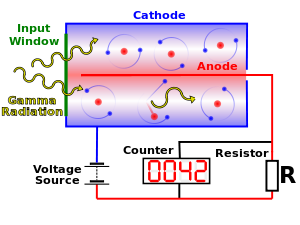Also discussed here: The sound of Bakersfield pollution
And here: Turning Air Pollution into Music(Alan Cross, Oct. 8, 2012)
And here: Scientists listen to the sun in new sonification project(Physorg, Feb. 26, 2010)
Today we look at a different way to analyze air pollution- by converting the sampling data into acoustics or “music”- a process called sonification. This approach has previously been applied to physics (Geiger counter) and astronomy (solar wind) data and opens up a new way that makes use of one’s hearing ability to detect and identify characteristics that were only seen visually.
Illustration of a Geiger-Müller tube. Based on a public domain image by
Kieran Maher (see original image) (Photo credit: Wikipedia)
Key Quotes:
“Turning data about dirty air into musical performances puts the need to keep our skies clean into a different context”
“The pair drew their air sample data from airborne particulates, separated in a gas chromatographer, and analyzed by a mass spectrometer for their exact chemical structure”
“The 'clean’ air is actually loaded with chemicals, off-gassing plant resins, and fragrances,..that create a more intricate and, I think, enjoyable sound. There are light pops and and crackles throughout the soundscape, in a way that reminds me of bees hurrying around a field. The polluted air, on the other hand, is just loaded with hydrocarbons, which lump up in the sound file to create a terrifying drone."
“Human hearing, in fact, is exquisitely sensitive at detecting the difference between subtle tones, as well as detecting patterns that might otherwise overwhelm our other senses”
“[ref solar wind data] In this sonification, we can actually hear in the data when the temperature goes up, or when the density increases,”



No comments:
Post a Comment